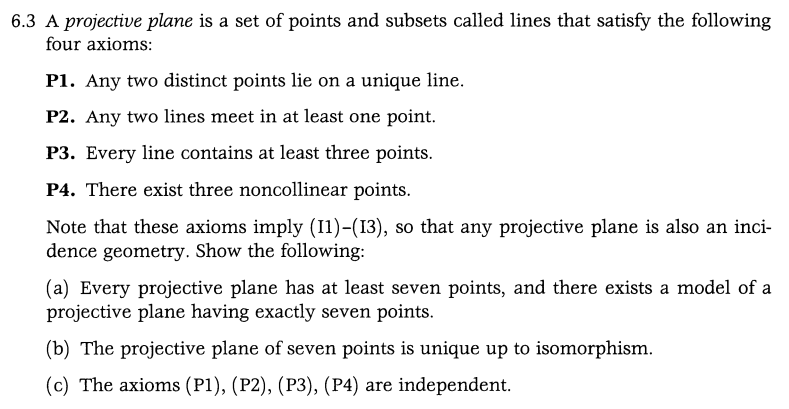5.3 (a) • Start from A,B,C be non-collinear. (why do you have that?) Can you look at line LAB, IBC, ICA (why these give you lines?), and find one more new point D, E, F on each of them? • Now can you find another point on AE, say point G? 5.3(b) • Can you first recall a projective plane of 7 points that you have seen in tutorial? (the Fano plane) • Can you show that every projective plane of 7 points is isomorphic to the Fano plane? (We will discuss more on isomorphism in detail this Thursday, although you probably have already heard of this from the tutorial.) 5.3(c) We have listed many examples when verifying the axioms of incidence during lecture, you might want to review that part, to be honest, many of the examples there still work =) (for sure I vill help you review the independence on Thursday)
5.3 (a) • Start from A,B,C be non-collinear. (why do you have that?) Can you look at line LAB, IBC, ICA (why these give you lines?), and find one more new point D, E, F on each of them? • Now can you find another point on AE, say point G? 5.3(b) • Can you first recall a projective plane of 7 points that you have seen in tutorial? (the Fano plane) • Can you show that every projective plane of 7 points is isomorphic to the Fano plane? (We will discuss more on isomorphism in detail this Thursday, although you probably have already heard of this from the tutorial.) 5.3(c) We have listed many examples when verifying the axioms of incidence during lecture, you might want to review that part, to be honest, many of the examples there still work =) (for sure I vill help you review the independence on Thursday)
Linear Algebra: A Modern Introduction
4th Edition
ISBN:9781285463247
Author:David Poole
Publisher:David Poole
Chapter1: Vectors
Section1.2: Length And Angle: The Dot Product
Problem 5AEXP
Related questions
Question
100%
[Geometry] How do you solve this? The second photo has hints
I1: Given any two discrete points there exists a unique line containing the,
I2: Given any line there exists at least two distinct points lying on it
I3: There exists three non-collinear points

Transcribed Image Text:6.3 (a)
• Start from A,B,C be non-collinear. (why do you have that?)
• Can you look at line LAB, IBC, ICA (why these give you lines?), and find one more new point D, E, F on each of them?
• Now can you find another point on LAE, say point G?
6.3(b)
• Can you first recall a projective plane of 7 points that you have seen in tutorial? (the Fano plane)
• Can you show that every projective plane of 7 points is isomorphic to the Fano plane? (We will discuss more on isomorphism in detail this Thursday, although you probably have already
heard of this from the tutorial.)
6.3(c) We have listed many examples when verifying the axioms of incidence during lecture, you might want to review that part, to be honest, many of the examples there still work =) (for sure I
will help you review the independence on Thursday)

Transcribed Image Text:6.3 A projective plane is a set of points and subsets called lines that satisfy the following
four axioms:
Pl. Any two distinct points lie on a unique line.
P2. Any two lines meet in at least one point.
P3. Every line contains at least three points.
P4. There exist three noncollinear points.
Note that these axioms imply (11)-(13), so that any projective plane is also an inci-
dence geometry. Show the following:
(a) Every projective plane has at least seven points, and there exists a model of a
projective plane having exactly seven points.
(b) The projective plane of seven points is unique up to isomorphism.
(c) The axioms (P1), (P2), (P3), (P4) are independent.
Expert Solution
This question has been solved!
Explore an expertly crafted, step-by-step solution for a thorough understanding of key concepts.
Step by step
Solved in 4 steps with 4 images

Recommended textbooks for you

Linear Algebra: A Modern Introduction
Algebra
ISBN:
9781285463247
Author:
David Poole
Publisher:
Cengage Learning

Algebra & Trigonometry with Analytic Geometry
Algebra
ISBN:
9781133382119
Author:
Swokowski
Publisher:
Cengage

Elements Of Modern Algebra
Algebra
ISBN:
9781285463230
Author:
Gilbert, Linda, Jimmie
Publisher:
Cengage Learning,

Linear Algebra: A Modern Introduction
Algebra
ISBN:
9781285463247
Author:
David Poole
Publisher:
Cengage Learning

Algebra & Trigonometry with Analytic Geometry
Algebra
ISBN:
9781133382119
Author:
Swokowski
Publisher:
Cengage

Elements Of Modern Algebra
Algebra
ISBN:
9781285463230
Author:
Gilbert, Linda, Jimmie
Publisher:
Cengage Learning,

Elementary Geometry for College Students
Geometry
ISBN:
9781285195698
Author:
Daniel C. Alexander, Geralyn M. Koeberlein
Publisher:
Cengage Learning